University Decision Making: MGT602 Business Decision Analytics Report
VerifiedAdded on 2022/08/28
|8
|1589
|15
Report
AI Summary
This report presents an analysis of a student's decision-making process, focusing on a significant personal decision: whether to accept a new job offer or remain in their current position. The analysis incorporates a decision style instrument and a Sixteen Personality Type test to evaluate the student's preferences and personality. The results indicate an intuition-based decision-making style, aligning with the student's INFP personality type. The report includes feedback from classmates, offering alternative perspectives on the decision and the role of intuition versus logic. A visualization of the decision-making process is also provided, along with references to support the analysis. The student ultimately decided to maintain their current position, with the report highlighting the factors influencing this choice.
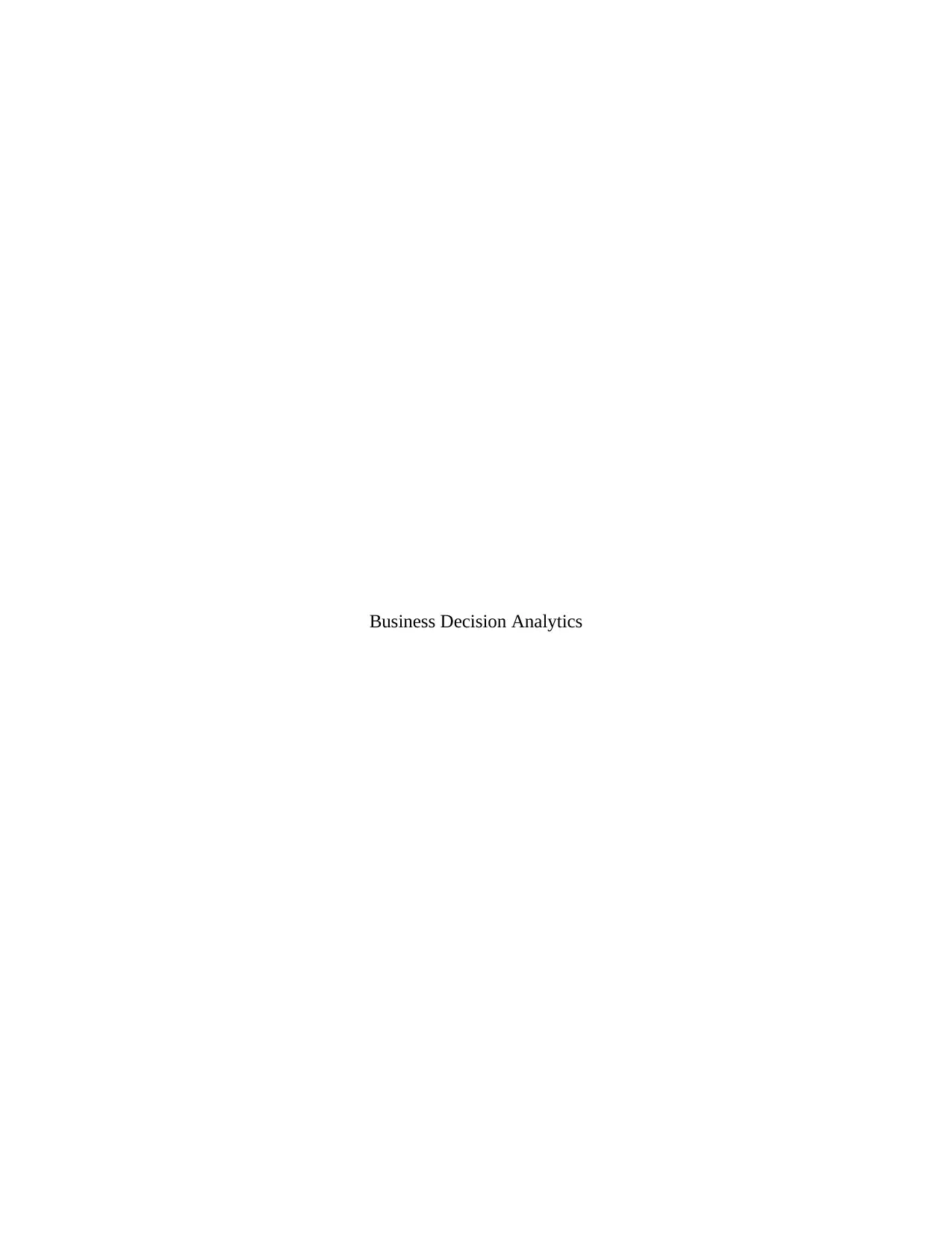
Business Decision Analytics
Paraphrase This Document
Need a fresh take? Get an instant paraphrase of this document with our AI Paraphraser
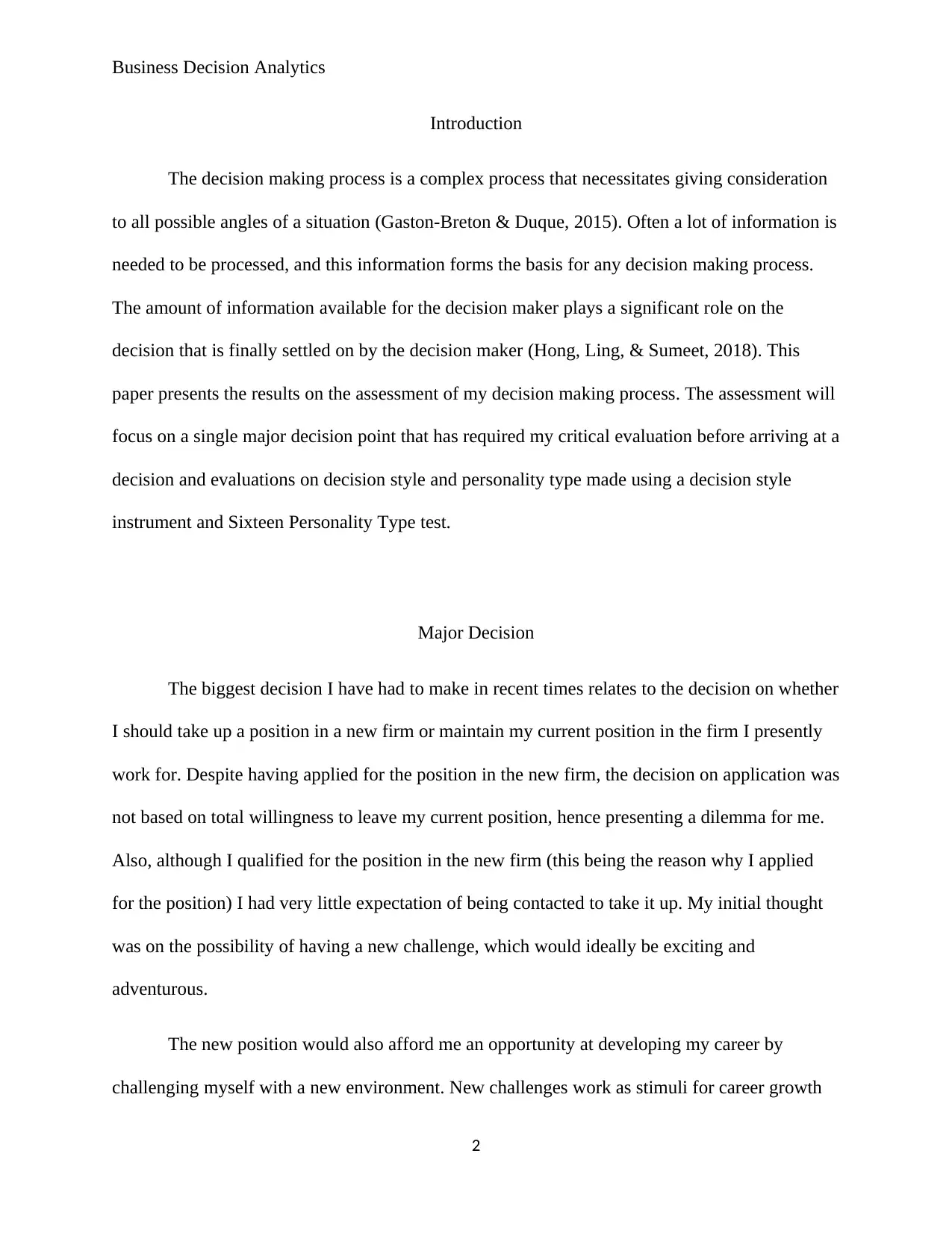
Business Decision Analytics
Introduction
The decision making process is a complex process that necessitates giving consideration
to all possible angles of a situation (Gaston-Breton & Duque, 2015). Often a lot of information is
needed to be processed, and this information forms the basis for any decision making process.
The amount of information available for the decision maker plays a significant role on the
decision that is finally settled on by the decision maker (Hong, Ling, & Sumeet, 2018). This
paper presents the results on the assessment of my decision making process. The assessment will
focus on a single major decision point that has required my critical evaluation before arriving at a
decision and evaluations on decision style and personality type made using a decision style
instrument and Sixteen Personality Type test.
Major Decision
The biggest decision I have had to make in recent times relates to the decision on whether
I should take up a position in a new firm or maintain my current position in the firm I presently
work for. Despite having applied for the position in the new firm, the decision on application was
not based on total willingness to leave my current position, hence presenting a dilemma for me.
Also, although I qualified for the position in the new firm (this being the reason why I applied
for the position) I had very little expectation of being contacted to take it up. My initial thought
was on the possibility of having a new challenge, which would ideally be exciting and
adventurous.
The new position would also afford me an opportunity at developing my career by
challenging myself with a new environment. New challenges work as stimuli for career growth
2
Introduction
The decision making process is a complex process that necessitates giving consideration
to all possible angles of a situation (Gaston-Breton & Duque, 2015). Often a lot of information is
needed to be processed, and this information forms the basis for any decision making process.
The amount of information available for the decision maker plays a significant role on the
decision that is finally settled on by the decision maker (Hong, Ling, & Sumeet, 2018). This
paper presents the results on the assessment of my decision making process. The assessment will
focus on a single major decision point that has required my critical evaluation before arriving at a
decision and evaluations on decision style and personality type made using a decision style
instrument and Sixteen Personality Type test.
Major Decision
The biggest decision I have had to make in recent times relates to the decision on whether
I should take up a position in a new firm or maintain my current position in the firm I presently
work for. Despite having applied for the position in the new firm, the decision on application was
not based on total willingness to leave my current position, hence presenting a dilemma for me.
Also, although I qualified for the position in the new firm (this being the reason why I applied
for the position) I had very little expectation of being contacted to take it up. My initial thought
was on the possibility of having a new challenge, which would ideally be exciting and
adventurous.
The new position would also afford me an opportunity at developing my career by
challenging myself with a new environment. New challenges work as stimuli for career growth
2
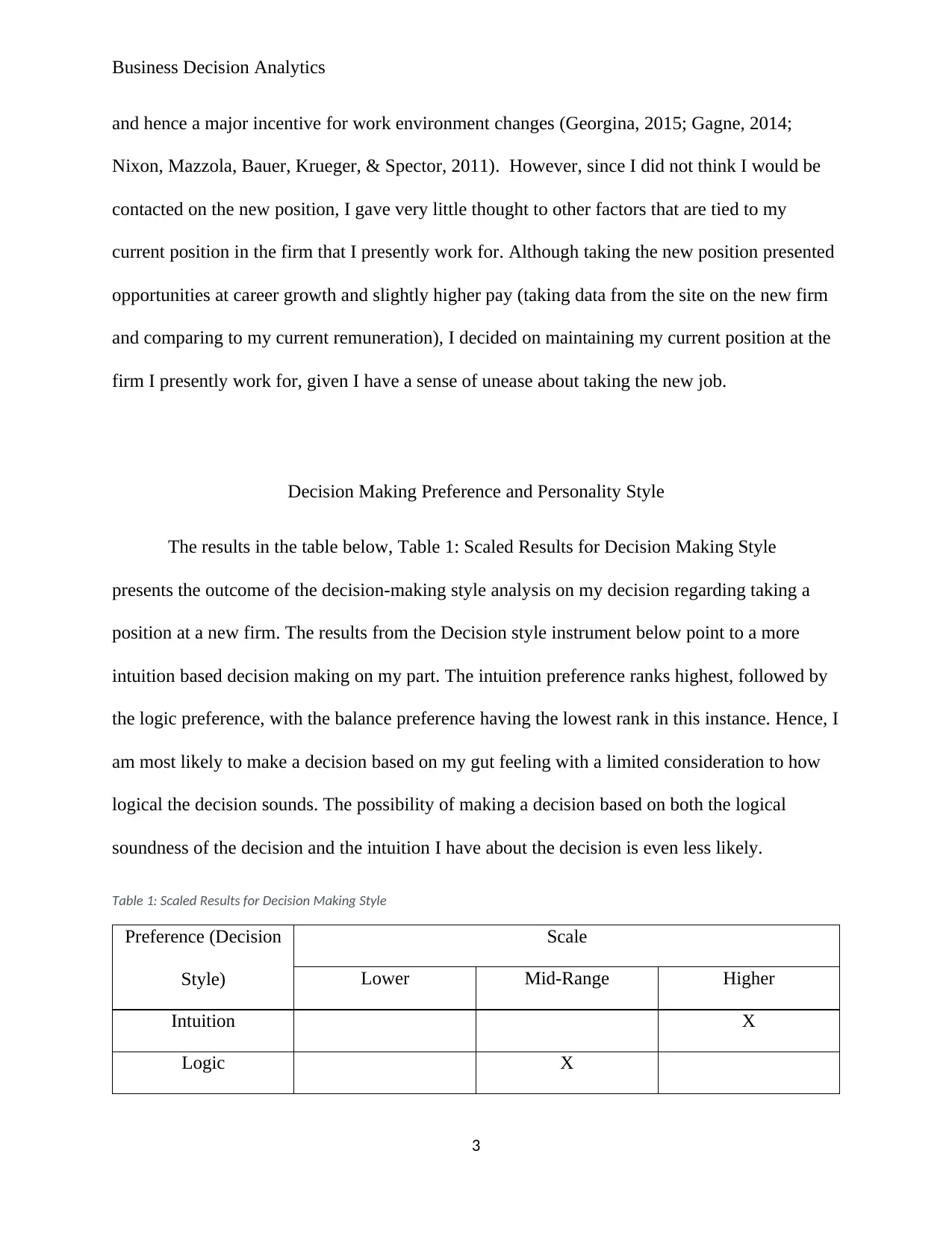
Business Decision Analytics
and hence a major incentive for work environment changes (Georgina, 2015; Gagne, 2014;
Nixon, Mazzola, Bauer, Krueger, & Spector, 2011). However, since I did not think I would be
contacted on the new position, I gave very little thought to other factors that are tied to my
current position in the firm that I presently work for. Although taking the new position presented
opportunities at career growth and slightly higher pay (taking data from the site on the new firm
and comparing to my current remuneration), I decided on maintaining my current position at the
firm I presently work for, given I have a sense of unease about taking the new job.
Decision Making Preference and Personality Style
The results in the table below, Table 1: Scaled Results for Decision Making Style
presents the outcome of the decision-making style analysis on my decision regarding taking a
position at a new firm. The results from the Decision style instrument below point to a more
intuition based decision making on my part. The intuition preference ranks highest, followed by
the logic preference, with the balance preference having the lowest rank in this instance. Hence, I
am most likely to make a decision based on my gut feeling with a limited consideration to how
logical the decision sounds. The possibility of making a decision based on both the logical
soundness of the decision and the intuition I have about the decision is even less likely.
Table 1: Scaled Results for Decision Making Style
Preference (Decision
Style)
Scale
Lower Mid-Range Higher
Intuition X
Logic X
3
and hence a major incentive for work environment changes (Georgina, 2015; Gagne, 2014;
Nixon, Mazzola, Bauer, Krueger, & Spector, 2011). However, since I did not think I would be
contacted on the new position, I gave very little thought to other factors that are tied to my
current position in the firm that I presently work for. Although taking the new position presented
opportunities at career growth and slightly higher pay (taking data from the site on the new firm
and comparing to my current remuneration), I decided on maintaining my current position at the
firm I presently work for, given I have a sense of unease about taking the new job.
Decision Making Preference and Personality Style
The results in the table below, Table 1: Scaled Results for Decision Making Style
presents the outcome of the decision-making style analysis on my decision regarding taking a
position at a new firm. The results from the Decision style instrument below point to a more
intuition based decision making on my part. The intuition preference ranks highest, followed by
the logic preference, with the balance preference having the lowest rank in this instance. Hence, I
am most likely to make a decision based on my gut feeling with a limited consideration to how
logical the decision sounds. The possibility of making a decision based on both the logical
soundness of the decision and the intuition I have about the decision is even less likely.
Table 1: Scaled Results for Decision Making Style
Preference (Decision
Style)
Scale
Lower Mid-Range Higher
Intuition X
Logic X
3
⊘ This is a preview!⊘
Do you want full access?
Subscribe today to unlock all pages.

Trusted by 1+ million students worldwide
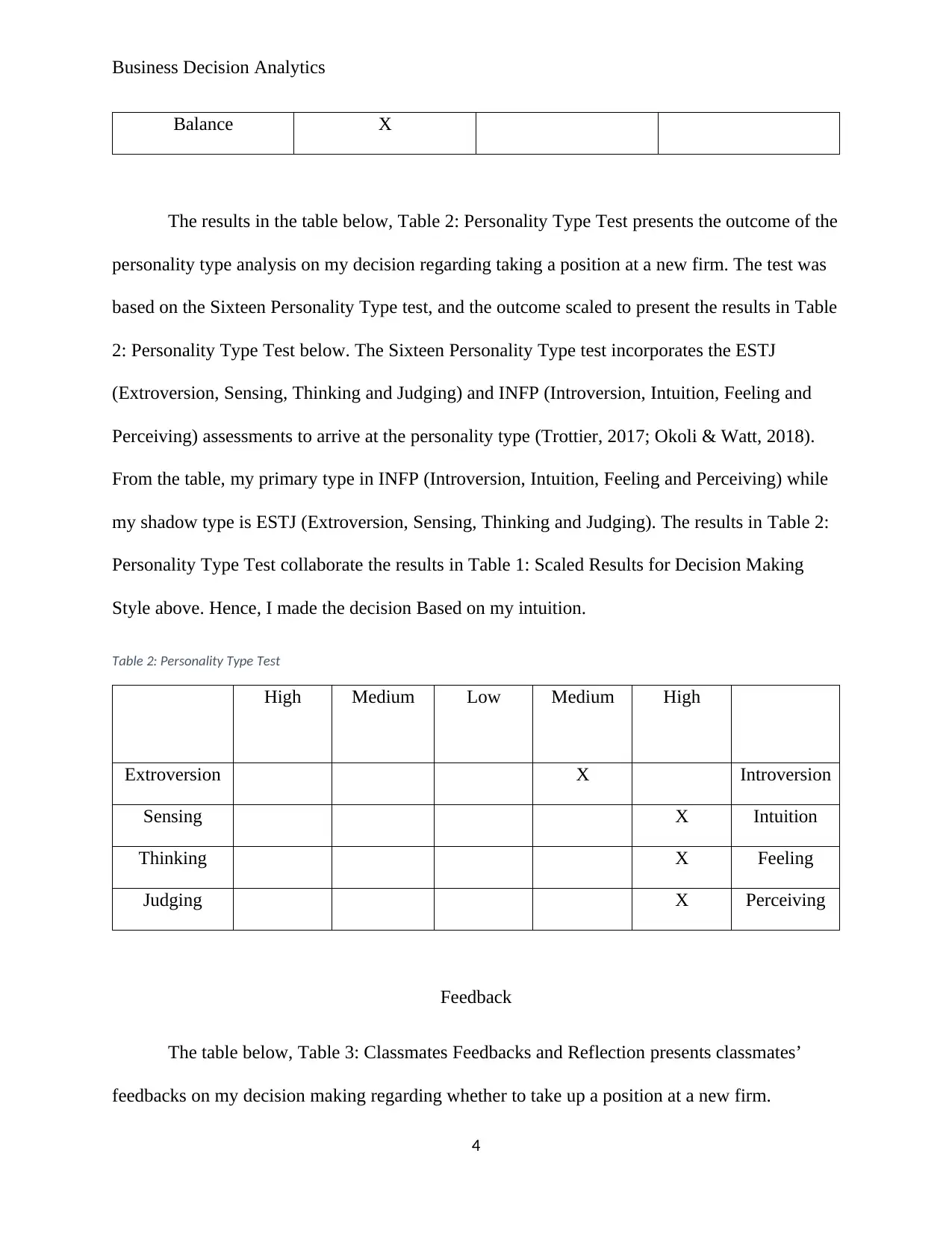
Business Decision Analytics
Balance X
The results in the table below, Table 2: Personality Type Test presents the outcome of the
personality type analysis on my decision regarding taking a position at a new firm. The test was
based on the Sixteen Personality Type test, and the outcome scaled to present the results in Table
2: Personality Type Test below. The Sixteen Personality Type test incorporates the ESTJ
(Extroversion, Sensing, Thinking and Judging) and INFP (Introversion, Intuition, Feeling and
Perceiving) assessments to arrive at the personality type (Trottier, 2017; Okoli & Watt, 2018).
From the table, my primary type in INFP (Introversion, Intuition, Feeling and Perceiving) while
my shadow type is ESTJ (Extroversion, Sensing, Thinking and Judging). The results in Table 2:
Personality Type Test collaborate the results in Table 1: Scaled Results for Decision Making
Style above. Hence, I made the decision Based on my intuition.
Table 2: Personality Type Test
High Medium Low Medium High
Extroversion X Introversion
Sensing X Intuition
Thinking X Feeling
Judging X Perceiving
Feedback
The table below, Table 3: Classmates Feedbacks and Reflection presents classmates’
feedbacks on my decision making regarding whether to take up a position at a new firm.
4
Balance X
The results in the table below, Table 2: Personality Type Test presents the outcome of the
personality type analysis on my decision regarding taking a position at a new firm. The test was
based on the Sixteen Personality Type test, and the outcome scaled to present the results in Table
2: Personality Type Test below. The Sixteen Personality Type test incorporates the ESTJ
(Extroversion, Sensing, Thinking and Judging) and INFP (Introversion, Intuition, Feeling and
Perceiving) assessments to arrive at the personality type (Trottier, 2017; Okoli & Watt, 2018).
From the table, my primary type in INFP (Introversion, Intuition, Feeling and Perceiving) while
my shadow type is ESTJ (Extroversion, Sensing, Thinking and Judging). The results in Table 2:
Personality Type Test collaborate the results in Table 1: Scaled Results for Decision Making
Style above. Hence, I made the decision Based on my intuition.
Table 2: Personality Type Test
High Medium Low Medium High
Extroversion X Introversion
Sensing X Intuition
Thinking X Feeling
Judging X Perceiving
Feedback
The table below, Table 3: Classmates Feedbacks and Reflection presents classmates’
feedbacks on my decision making regarding whether to take up a position at a new firm.
4
Paraphrase This Document
Need a fresh take? Get an instant paraphrase of this document with our AI Paraphraser
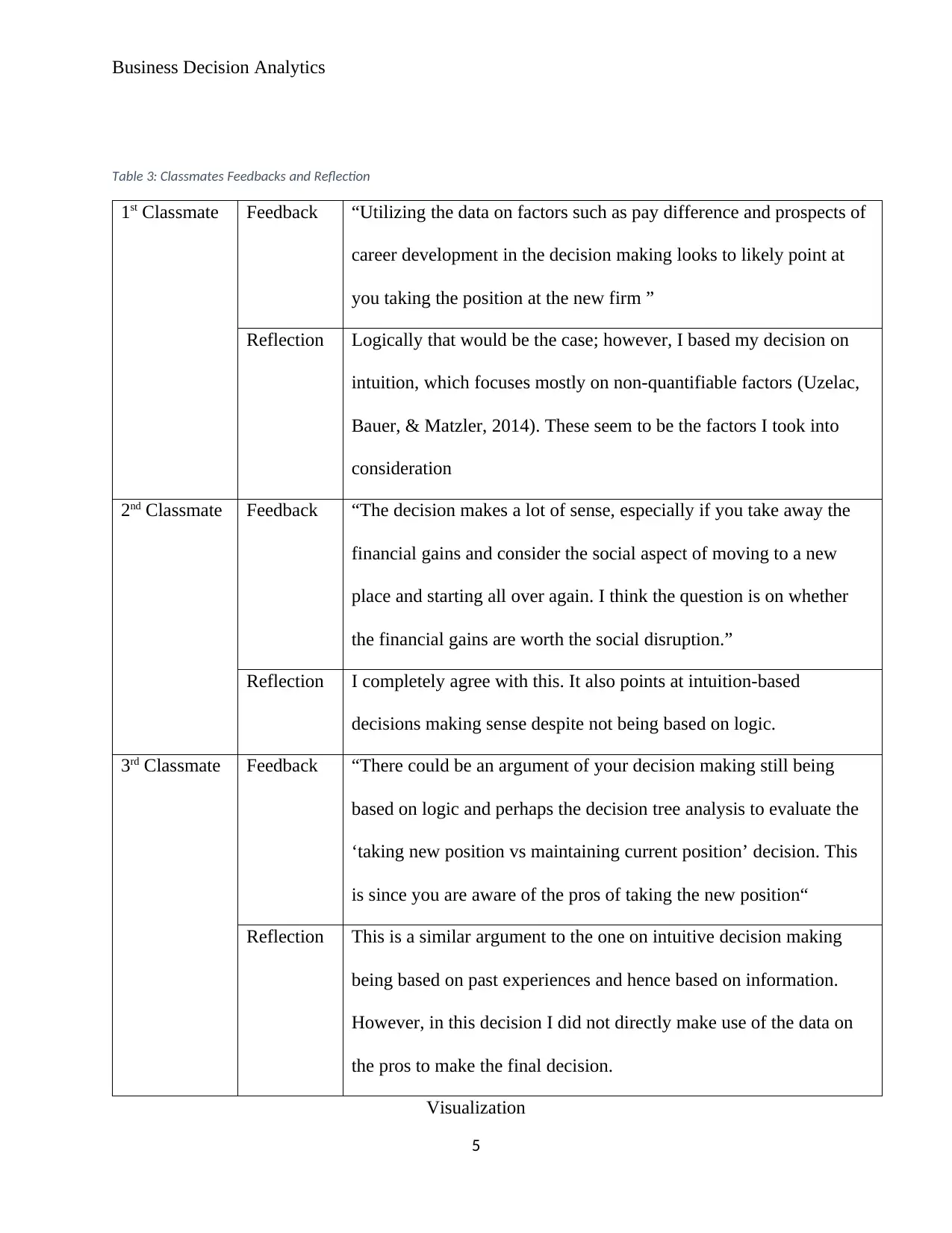
Business Decision Analytics
Table 3: Classmates Feedbacks and Reflection
1st Classmate Feedback “Utilizing the data on factors such as pay difference and prospects of
career development in the decision making looks to likely point at
you taking the position at the new firm ”
Reflection Logically that would be the case; however, I based my decision on
intuition, which focuses mostly on non-quantifiable factors (Uzelac,
Bauer, & Matzler, 2014). These seem to be the factors I took into
consideration
2nd Classmate Feedback “The decision makes a lot of sense, especially if you take away the
financial gains and consider the social aspect of moving to a new
place and starting all over again. I think the question is on whether
the financial gains are worth the social disruption.”
Reflection I completely agree with this. It also points at intuition-based
decisions making sense despite not being based on logic.
3rd Classmate Feedback “There could be an argument of your decision making still being
based on logic and perhaps the decision tree analysis to evaluate the
‘taking new position vs maintaining current position’ decision. This
is since you are aware of the pros of taking the new position“
Reflection This is a similar argument to the one on intuitive decision making
being based on past experiences and hence based on information.
However, in this decision I did not directly make use of the data on
the pros to make the final decision.
Visualization
5
Table 3: Classmates Feedbacks and Reflection
1st Classmate Feedback “Utilizing the data on factors such as pay difference and prospects of
career development in the decision making looks to likely point at
you taking the position at the new firm ”
Reflection Logically that would be the case; however, I based my decision on
intuition, which focuses mostly on non-quantifiable factors (Uzelac,
Bauer, & Matzler, 2014). These seem to be the factors I took into
consideration
2nd Classmate Feedback “The decision makes a lot of sense, especially if you take away the
financial gains and consider the social aspect of moving to a new
place and starting all over again. I think the question is on whether
the financial gains are worth the social disruption.”
Reflection I completely agree with this. It also points at intuition-based
decisions making sense despite not being based on logic.
3rd Classmate Feedback “There could be an argument of your decision making still being
based on logic and perhaps the decision tree analysis to evaluate the
‘taking new position vs maintaining current position’ decision. This
is since you are aware of the pros of taking the new position“
Reflection This is a similar argument to the one on intuitive decision making
being based on past experiences and hence based on information.
However, in this decision I did not directly make use of the data on
the pros to make the final decision.
Visualization
5
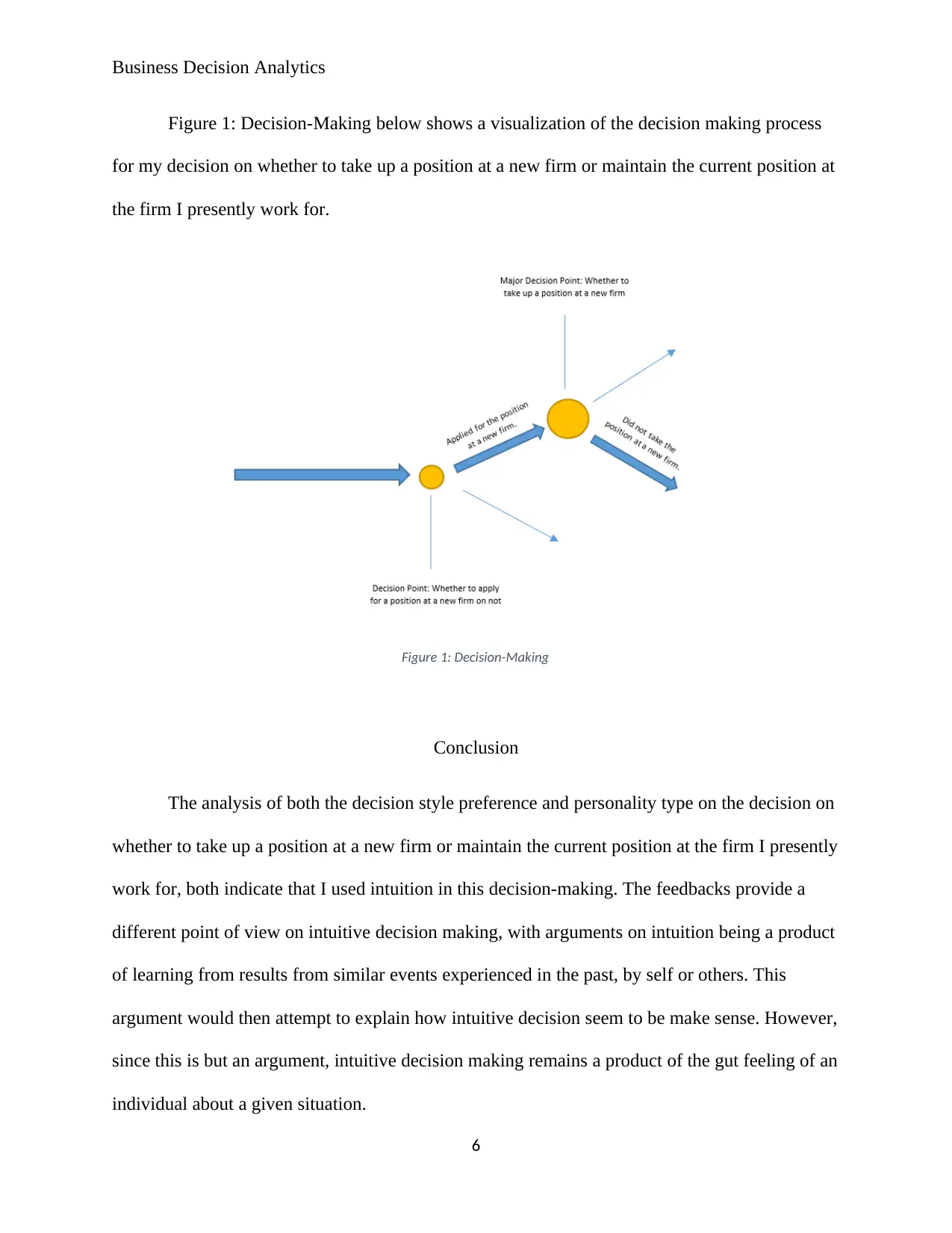
Business Decision Analytics
Figure 1: Decision-Making below shows a visualization of the decision making process
for my decision on whether to take up a position at a new firm or maintain the current position at
the firm I presently work for.
Figure 1: Decision-Making
Conclusion
The analysis of both the decision style preference and personality type on the decision on
whether to take up a position at a new firm or maintain the current position at the firm I presently
work for, both indicate that I used intuition in this decision-making. The feedbacks provide a
different point of view on intuitive decision making, with arguments on intuition being a product
of learning from results from similar events experienced in the past, by self or others. This
argument would then attempt to explain how intuitive decision seem to be make sense. However,
since this is but an argument, intuitive decision making remains a product of the gut feeling of an
individual about a given situation.
6
Figure 1: Decision-Making below shows a visualization of the decision making process
for my decision on whether to take up a position at a new firm or maintain the current position at
the firm I presently work for.
Figure 1: Decision-Making
Conclusion
The analysis of both the decision style preference and personality type on the decision on
whether to take up a position at a new firm or maintain the current position at the firm I presently
work for, both indicate that I used intuition in this decision-making. The feedbacks provide a
different point of view on intuitive decision making, with arguments on intuition being a product
of learning from results from similar events experienced in the past, by self or others. This
argument would then attempt to explain how intuitive decision seem to be make sense. However,
since this is but an argument, intuitive decision making remains a product of the gut feeling of an
individual about a given situation.
6
⊘ This is a preview!⊘
Do you want full access?
Subscribe today to unlock all pages.

Trusted by 1+ million students worldwide

Business Decision Analytics
References
7
References
7
Paraphrase This Document
Need a fresh take? Get an instant paraphrase of this document with our AI Paraphraser
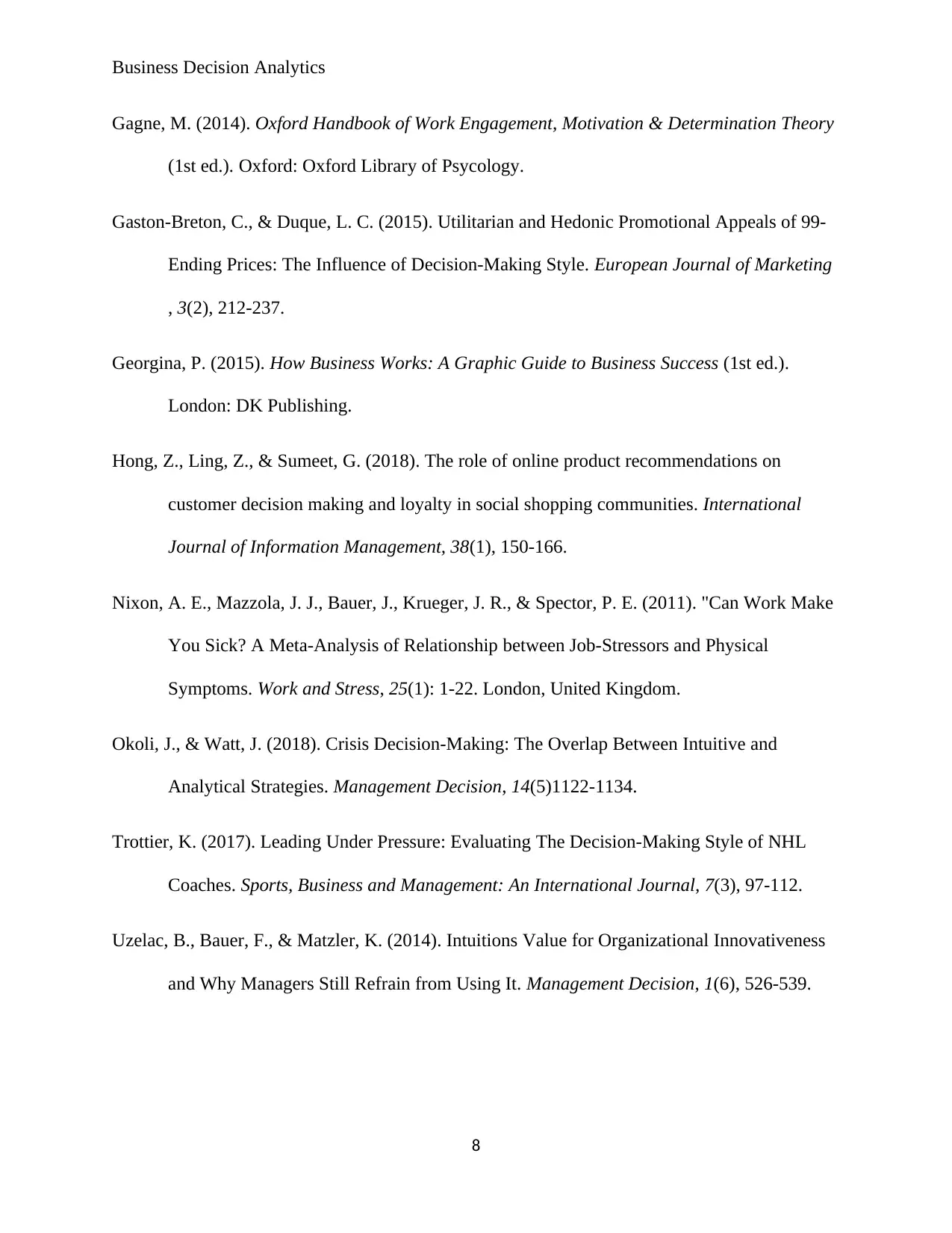
Business Decision Analytics
Gagne, M. (2014). Oxford Handbook of Work Engagement, Motivation & Determination Theory
(1st ed.). Oxford: Oxford Library of Psycology.
Gaston-Breton, C., & Duque, L. C. (2015). Utilitarian and Hedonic Promotional Appeals of 99-
Ending Prices: The Influence of Decision-Making Style. European Journal of Marketing
, 3(2), 212-237.
Georgina, P. (2015). How Business Works: A Graphic Guide to Business Success (1st ed.).
London: DK Publishing.
Hong, Z., Ling, Z., & Sumeet, G. (2018). The role of online product recommendations on
customer decision making and loyalty in social shopping communities. International
Journal of Information Management, 38(1), 150-166.
Nixon, A. E., Mazzola, J. J., Bauer, J., Krueger, J. R., & Spector, P. E. (2011). "Can Work Make
You Sick? A Meta-Analysis of Relationship between Job-Stressors and Physical
Symptoms. Work and Stress, 25(1): 1-22. London, United Kingdom.
Okoli, J., & Watt, J. (2018). Crisis Decision-Making: The Overlap Between Intuitive and
Analytical Strategies. Management Decision, 14(5)1122-1134.
Trottier, K. (2017). Leading Under Pressure: Evaluating The Decision-Making Style of NHL
Coaches. Sports, Business and Management: An International Journal, 7(3), 97-112.
Uzelac, B., Bauer, F., & Matzler, K. (2014). Intuitions Value for Organizational Innovativeness
and Why Managers Still Refrain from Using It. Management Decision, 1(6), 526-539.
8
Gagne, M. (2014). Oxford Handbook of Work Engagement, Motivation & Determination Theory
(1st ed.). Oxford: Oxford Library of Psycology.
Gaston-Breton, C., & Duque, L. C. (2015). Utilitarian and Hedonic Promotional Appeals of 99-
Ending Prices: The Influence of Decision-Making Style. European Journal of Marketing
, 3(2), 212-237.
Georgina, P. (2015). How Business Works: A Graphic Guide to Business Success (1st ed.).
London: DK Publishing.
Hong, Z., Ling, Z., & Sumeet, G. (2018). The role of online product recommendations on
customer decision making and loyalty in social shopping communities. International
Journal of Information Management, 38(1), 150-166.
Nixon, A. E., Mazzola, J. J., Bauer, J., Krueger, J. R., & Spector, P. E. (2011). "Can Work Make
You Sick? A Meta-Analysis of Relationship between Job-Stressors and Physical
Symptoms. Work and Stress, 25(1): 1-22. London, United Kingdom.
Okoli, J., & Watt, J. (2018). Crisis Decision-Making: The Overlap Between Intuitive and
Analytical Strategies. Management Decision, 14(5)1122-1134.
Trottier, K. (2017). Leading Under Pressure: Evaluating The Decision-Making Style of NHL
Coaches. Sports, Business and Management: An International Journal, 7(3), 97-112.
Uzelac, B., Bauer, F., & Matzler, K. (2014). Intuitions Value for Organizational Innovativeness
and Why Managers Still Refrain from Using It. Management Decision, 1(6), 526-539.
8
1 out of 8
Related Documents
Your All-in-One AI-Powered Toolkit for Academic Success.
+13062052269
info@desklib.com
Available 24*7 on WhatsApp / Email
![[object Object]](/_next/static/media/star-bottom.7253800d.svg)
Unlock your academic potential
Copyright © 2020–2025 A2Z Services. All Rights Reserved. Developed and managed by ZUCOL.


